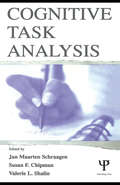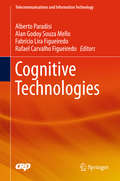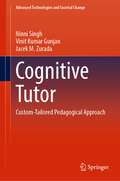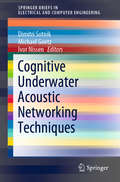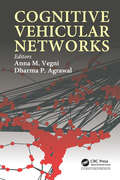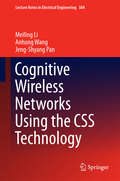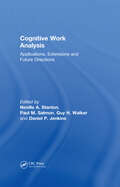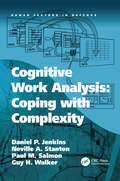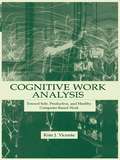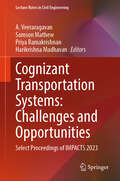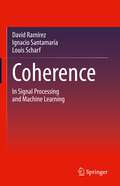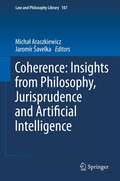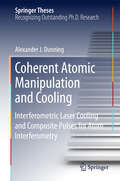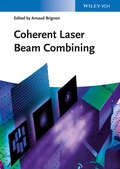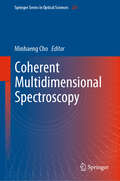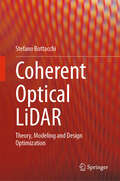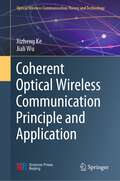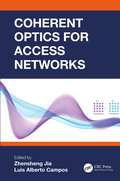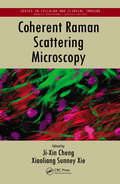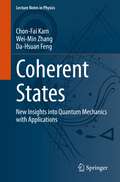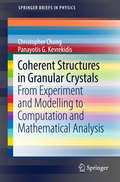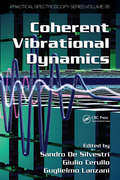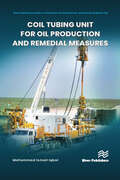- Table View
- List View
Cognitive Task Analysis (Expertise: Research and Applications Series)
by Jan Maarten Schraagen Susan F. Chipman Valerie L. ShalinCognitive task analysis is a broad area consisting of tools and techniques for describing the knowledge and strategies required for task performance. Cognitive task analysis has implications for the development of expert systems, training and instructional design, expert decision making and policymaking. It has been applied in a wide range of settings, with different purposes, for instance: specifying user requirements in system design or specifying training requirements in training needs analysis. The topics to be covered by this work include: general approaches to cognitive task analysis, system design, instruction, and cognitive task analysis for teams. The work settings to which the tools and techniques described in this work have been applied include: 911 dispatching, faultfinding on board naval ships, design aircraft, and various support systems. The editors' goal in this book is to present in a single source a comprehensive, in-depth introduction to the field of cognitive task analysis. They have attempted to include as many examples as possible in the book, making it highly suitable for those wishing to undertake a cognitive task analysis themselves. The book also contains a historical introduction to the field and an annotated bibliography, making it an excellent guide to additional resources.
Cognitive Technologies (Telecommunications and Information Technology)
by Alberto Paradisi Fabrício Lira Figueiredo Alan Godoy Souza Mello Rafael Carvalho FigueiredoThis book focuses on the next generation optical networks as well as mobile communication technologies. The reader will find chapters on Cognitive Optical Network, 5G Cognitive Wireless, LTE, Data Analysis and Natural Language Processing. It also presents a comprehensive view of the enhancements and requirements foreseen for Machine Type Communication. Moreover, some data analysis techniques and Brazilian Portuguese natural language processing technologies are also described here.
Cognitive Tutor: Custom-Tailored Pedagogical Approach (Advanced Technologies and Societal Change)
by Vinit Kumar Gunjan Jacek M. Zurada Ninni SinghThis book illustrates the design, development, and evaluation of personalized intelligent tutoring systems that emulate human cognitive intelligence by incorporating artificial intelligence. Artificial intelligence is an advanced field of research. It is particularly used in the field of education to increase the effectiveness of teaching and learning techniques. With the advancement of internet technology, there is a rapid growth in web based distance learning modality. This mode of learning is better known as the e-learning system. These systems present low intelligence because they offer a pre-identified learning frame to their learners. The advantage of these systems is to offer to learn anytime and anyplace without putting emphasis on a learner's needs, competency level, and previous knowledge. Every learner has different grasping levels, previous knowledge, and preferred mode of learning, and hence, the learning process of one individual may significantly vary from other individuals. This book provides a complete reference for students, researchers, and industry practitioners interested in keeping abreast of recent advancements in this field. It encompasses cognitive intelligence and artificial intelligence which are very important for deriving a roadmap for future research on intelligent systems.
Cognitive Underwater Acoustic Networking Techniques (SpringerBriefs in Electrical and Computer Engineering)
by Michael Goetz Ivor Nissen Dimitri SotnikThis book summarizes the latest research on cognitive network-layer methods and smart adaptive physical-layer methods in underwater networks. Underwater communication requires extendable and delay-tolerant underwater acoustic networks capable of supporting multiple frequency bands, data rates and transmission ranges. The book also discusses a suitable foreground communication stack for mixed mobile/static networks, a technology that requires adaptive physical layer waveforms and cognitive network strategies with underlying cooperative and non-cooperative robust processes. The goal is to arrive at a universally applicable standard in the area of Underwater Internet-of-Things [ISO/IEC 30140, 30142, 30143].
Cognitive Vehicular Networks
by Anna Maria Vegni Dharma P. AgrawalA comprehensive text on both current and emerging areas of cognitive vehicular networks, this book focuses on a new class of mobile ad hoc networks. It uses a pedagogical approach utilizing cognitive aspects applied to vehicular environments and comprises contributions from well-known and high profile researchers in their respective specialties. The book provides significant technical and practical insights on different perspectives, starting from a basic background on cognitive radio, interrelated technologies, application to vehicular networks, technical challenges, and future trends.
Cognitive Wireless Networks Using the CSS Technology (Lecture Notes in Electrical Engineering #384)
by Jeng-Shyang Pan Anhong Wang Meiling LiThe aim of this book is to provide someuseful methods to improve the spectrum sensing performance in a systematic way,and point out an effective method for the application of cognitive radiotechnology in wireless communications. The book gives a a state-of-the-artsurvey and proposes some new cooperative spectrum sensing (CSS) methodsattempting to achieve better performance. For each CSS, the main idea andcorresponding algorithm design are elaborated in detail. This book covers the fundamental concepts and the coretechnologies of CSS, especially its latest developments. Each chapter ispresented in a self-sufficient and independent way so that the reader canselect the chapters interesting to them. The methodologies are described indetail so that the readers can repeat the corresponding experiments easily. It will be a useful book for researchers helping them tounderstand the classifications of CSS, inspiring new ideas about the novel CSStechnology for CR, and learning new ideas from the current status of CSS. Forengineers, it will be a good guidebook to develop practical applications forCSS.
Cognitive Work Analysis: Applications, Extensions and Future Directions
by Daniel P. Jenkins Neville A. Stanton Guy H. Walker Paul M. SalmonOver the past decade, Cognitive Work Analysis (CWA) has been one of the popular human factors approaches for complex systems evaluation and design applications. This is reflected by a diverse range of applications across safety critical domains. The book brings together a series of CWA applications and discussions from world-leading human factors researchers and practitioners. It begins with an overview of the CWA framework, including its theoretical underpinnings, the methodological approaches involved (including practical guidance on each phase), and previous applications of the framework. The core of the book is a series of CWA applications, undertaken in a wide range of safety critical domains for a range of purposes. These serve to demonstrate the contribution that CWA can make to real-world projects and provide readers with inspiration for how such analyses can be practically carried out. Following this, a series of applications in which new approaches or adaptations have been added to the framework are presented. These show how practical applications feedback into the theories/approaches underpinning CWA. The closing chapter then speculates on future applications of the framework and on a series of new research directions required in order to enhance its utility. In emphasising the practical realities of performing CWA, and the real-world impacts it can provide, the book tackles several common misconceptions in a constructive and persuasive way. It provides a welcome demonstration of how CWA can be a powerful ally in tackling complexity-related problems that afflict systems in all areas.
Cognitive Work Analysis: Coping With Complexity (Human Factors in Defence)
by Daniel P. Jenkins Neville A. Stanton Guy H. Walker'Complex sociotechnical systems' are systems made up of numerous interacting parts, both human and non-human, operating in dynamic, ambiguous and safety critical domains. Cognitive Work Analysis (CWA) is a structured framework specifically developed for considering the development and analysis of these complex socio-technical systems. Unlike many human factors approaches, CWA does not focus on how human-system interaction should proceed (normative modelling) or how human-system interaction currently works (descriptive modelling). Instead, through a focus on constraints, it develops a model of how work can be conducted within a given work domain, without explicitly identifying specific sequences of actions (formative modelling). The framework leads the analyst to consider the environment the task takes place within, and the effect of the imposed constraints on the way work can be conducted. It provides guidance through the process of answering the questions of why the system exists, what activities can be conducted within the domain as well as how these activities can be achieved, and who can perform them. The first part of the book contains a comprehensive description of CWA, introducing it to the uninitiated. It then presents a number of applications in complex military domains to explore and develop the benefits of CWA. Unlike much of the previous literature, particular attention is placed on exploring the CWA framework in its entirety. This holistic approach focuses on the system environment, the activity that takes place within it, the strategies used to conduct this activity, the way in which the constituent parts of the system (both human and non-human) interact and the behaviour required. Each stage of this analysis identifies the constraints governing the system; it is contended that through this holistic understanding of constraints, recommendations can be made for the design of system interaction; increasing the ability of users to cope with unanticipated, unexpected situations. This book discusses the applicability of the approach in system analysis, development and evaluation. It provides process to what was previously a loosely defined framework.
Cognitive Work Analysis: Toward Safe, Productive, and Healthy Computer-Based Work
by Kim J. VicenteThis book describes, for the first time in pedagogical form, an approach to computer-based work in complex sociotechnical systems developed over the last 30 years by Jens Rasmussen and his colleagues at Risø National Laboratory in Roskilde, Denmark. This approach is represented by a framework called cognitive work analysis. Its goal is to help
Cognizant Transportation Systems: Select Proceedings of IMPACTS 2023 (Lecture Notes in Civil Engineering #263)
by A. Veeraragavan Samson Mathew Priya Ramakrishnan Harikrishna MadhavanThis book presents the select proceedings of the International Conference on Innovative Methods and Practical Applications for Cognizant Transportation Systems (IMPACTS 2023). It explores the most recent methods of analysis and design of transportation systems, such as congestion, traffic safety, and high pollution levels, that can adapt to the ever-changing demands of urbanization. This compilation of research papers on the themes of traffic engineering, pavement technology and transportation planning, intelligent transportation systems, and environmental sustainability presents a unique blend of pragmatism and theoretical perspective to the varied challenges that transportation systems face. This book is a valuable resource for researchers and professionals associated with transportation engineering.
Coherence: In Signal Processing and Machine Learning
by Louis Scharf David Ramírez Ignacio SantamaríaThis book organizes principles and methods of signal processing and machine learning into the framework of coherence. The book contains a wealth of classical and modern methods of inference, some reported here for the first time. General results are applied to problems in communications, cognitive radio, passive and active radar and sonar, multi-sensor array processing, spectrum analysis, hyperspectral imaging, subspace clustering, and related. The reader will find new results for model fitting; for dimension reduction in models and ambient spaces; for detection, estimation, and space-time series analysis; for subspace averaging; and for uncertainty quantification. Throughout, the transformation invariances of statistics are clarified, geometries are illuminated, and null distributions are given where tractable. Stochastic representations are emphasized, as these are central to Monte Carlo simulations. The appendices contain a comprehensive account of matrix theory, the SVD, the multivariate normal distribution, and many of the important distributions for coherence statistics. The book begins with a review of classical results in the physical and engineering sciences where coherence plays a fundamental role. Then least squares theory and the theory of minimum mean-squared error estimation are developed, with special attention paid to statistics that may be interpreted as coherence statistics. A chapter on classical hypothesis tests for covariance structure introduces the next three chapters on matched and adaptive subspace detectors. These detectors are derived from likelihood reasoning, but it is their geometries and invariances that qualify them as coherence statistics. A chapter on independence testing in space-time data sets leads to a definition of broadband coherence, and contains novel applications to cognitive radio and the analysis of cyclostationarity. The chapter on subspace averaging reviews basic results and derives an order-fitting rule for determining the dimension of an average subspace. These results are used to enumerate sources of acoustic and electromagnetic radiation and to cluster subspaces into similarity classes. The chapter on performance bounds and uncertainty quantification emphasizes the geometry of the Cramèr-Rao bound and its related information geometry.
Coherence: Insights From Philosophy, Jurisprudence And Artificial Intelligence (Law and Philosophy Library #107)
by Michał Araszkiewicz Jaromír ŠavelkaThis book is a thorough treatise concerned with coherence and its significance in legal reasoning. The individual chapters present the topic from the general philosophical perspective, the perspective of legal-theory as well as the viewpoint of cognitive sciences and the research on artificial intelligence and law. As it has turned out the interchange of knowledge among these disciplines is very fruitful for each of them, providing mutual inspiration and increasing understanding of a given topic. This book is a unique resource for anyone interested in the concept of coherence and the role it plays in reasoning. As this book captures important contemporary issues concerning the ongoing discussion on coherence and law, those interested in legal reasoning should find it particularly helpful. By presenting such a broad scope of views and methods on approaching the issue of coherence we hope to promote the general interest in the topic as well as the academic research that centers around coherence and law.
Coherent Atomic Manipulation and Cooling: Interferometric Laser Cooling and Composite Pulses for Atom Interferometry (Springer Theses)
by Alexander J. DunningThis work unites the concepts of laser cooling and matter-wave interferometry to develop an interferometric laser cooling technique in an experimental system of cold rubidium atoms. Serving as an introduction to graduate level coherent optical atomic manipulation, the thesis describes the theory of stimulated Raman transitions and atom interferometry, along with the experimental methods for preparing and manipulating cold atoms, before building on these foundations to explore tailored optical pulse sequences and novel atomic cooling techniques. Interferometric cooling, originally proposed by Weitz and Hänsch in 2000, is based upon the coherent broadband laser pulses of Ramsey interferometry and in principle allows laser cooling of atomic and molecular species outside the scope of traditional Doppler laser cooling. On the path toward cooling, composite pulses - quantum error correction methods, developed by chemists to mitigate the effects of in homogeneities in NMR spectroscopy - are investigated with a view to improving the performance of atom interferometers.
Coherent Laser Beam Combining
by Arnaud BrignonLaser beam combining techniques allow increasing the power of lasers far beyond what it is possible to obtain from a single conventional laser.One step further, coherent beam combining (CBC) also helps to maintain the very unique properties of the laser emission with respect to its spectral and spatial properties. Such lasers are of major interest for many applications, including industrial, environmental, defense, andscientific applications. Recently, significant progress has beenmade in coherent beam combining lasers, with a total output power of 100 kW already achieved. Scalinganalysis indicates that further increase of output power with excellent beam quality is feasible by using existing state-of-the-art lasers. Thus, the knowledge of coherent beam combining techniques will become crucial for the design of next-generation highpower lasers. The purpose of this book is to present the more recent concepts of coherent beam combining by world leader teams in the field.
Coherent Light-Matter Interactions in Monolayer Transition-Metal Dichalcogenides (Springer Theses)
by Edbert Jarvis SieThis thesis presents optical methods to split the energy levels of electronic valleys in transition-metal dichalcogenides (TMDs) by means of coherent light-matter interactions. The electronic valleys found in monolayer TMDs such as MoS2, WS2, and WSe2 are among the many novel properties exhibited by semiconductors when thinned down to a few atomic layers, and have have been proposed as a new way to carry information in next generation devices (so-called valleytronics). These valleys are, however, normally locked in the same energy level, which limits their potential use for applications. The author describes experiments performed with a pump-probe technique using transient absorption spectroscopy on MoS2 and WS2. It is demonstrated that hybridizing the electronic valleys with light allows one to optically tune their energy levels in a controllable valley-selective manner. In particular, by using off-resonance circularly polarized light at small detuning, one can tune the energy level of one valley through the optical Stark effect. Also presented within are observations, at larger detuning, of a separate contribution from the so-called Bloch--Siegert effect, a delicate phenomenon that has eluded direct observation in solids. The two effects obey opposite selection rules, enabling one to separate the two effects at two different valleys.
Coherent Multidimensional Spectroscopy (Springer Series in Optical Sciences #226)
by Minhaeng ChoThis book will fulfill the needs of time-domain spectroscopists who wish to deepen their understanding of both the theoretical and experimental features of this cutting-edge spectroscopy technique. Coherent Multidimensional Spectroscopy (CMDS) is a state-of-the-art technique with applications in a variety of subjects like chemistry, molecular physics, biochemistry, biophysics, and material science. Due to dramatic advancements of ultrafast laser technologies, diverse multidimensional spectroscopic methods utilizing combinations of THz, IR, visible, UV, and X-ray radiation sources have been developed and used to study real time dynamics of small molecules in solutions, proteins and nucleic acids in condensed phases and membranes, single and multiple excitons in functional materials like semiconductors, quantum dots, and solar cells, photo-excited states in light-harvesting complexes, ions in battery electrolytes, electronic and conformational changes in charge or proton transfer systems, and excess electrons and protons in water and biological systems.
Coherent Optical LiDAR: Theory, Modeling and Design Optimization
by Stefano BottacchiThis book provides an insight into the coherent optical LiDAR system, starting from the fundamental operation of the polarization diversity coherent optical transceiver, widely used in field deployed Terabit optical communication systems. The author first defines LiDAR, i.e., Light Detection and Ranging, as a complex machine designed to measure the distance and the velocity of the target object in a two-dimensional imaging. The book provides a detailed analysis of the electrical engineering aspects of the Code-Modulated (CM) LiDAR, developing a thorough theory and modeling of coherent optical signals and noise sources involved in the detection of the received signal by means of the integrated coherent optical receiver. The author then shows that the target detection of the CM LiDAR is based on the cross-correlation process between the transmitted and received coded signals after the target reflection. To this end, large part of the book is devoted to the theory of the cross-correlation process with noise and the related probability of detection. The intent of this book is to provide a reference to the reader for the inside understanding of the coherent optical LiDAR toward an optimum design approach. Presents coherent optical LiDAR systems, which measure distance and velocity of the target in a two-dimensional imaging. Illustrates how LiDAR offers an ideal solution for low-cost and large-scale integration. Merges LiDAR specifications and optical coherent technology through a unique approach.
Coherent Optical Wireless Communication Principle and Application (Optical Wireless Communication Theory and Technology)
by Xizheng Ke Jiali WuThis book presents the key technologies of coherent optical wireless communication, covers topics such as beam coupling, signal optical polarization control and distorted wavefront correction. It discusses the principle of coherent optical communication and heterodyne detection conditions. In this book, the array coupling receiving technology and large aperture coupling technology are introduced to realize the spatial optical fiber coupling; simulated annealing algorithm, particle swarm optimization algorithm and SPO algorithm are used to control the polarization state of the signal beam; and the correction of distorted wavefront of the signal beam by adaptive optics technology and wavefront sensorless adaptive optics technology are analyzed, and the influence of beam mode on coherent detection performance is elaborated. Both theoretical deduction and experimental results are included in this book, which can help readers further understand the theoretical knowledge.
Coherent Optics for Access Networks
by Zhensheng Jia Luis Alberto CamposThis book will highlight the motivation for coherent optics in access and introduce digital coherent optical systemin detail, including advanced modulation formats, architecture of modulation and detection, and DSP flow forboth transmitter and receiver. This book will also demonstrate potential approaches to re-design and re-engineerthe digital coherent concept from long-haul and metro solutions to the access network, leveraging reduction incomplexity and cost as well as the benefits of capacity increases and operational improvements. This book will illustrate the details on optimization of the digital, optical, and electrical complexity and standardization and interoperability.
Coherent Raman Scattering Microscopy (Series in Cellular and Clinical Imaging)
by Ji-Xin Cheng Xiaoliang Sunney XieThe First Book on CRS MicroscopyCompared to conventional Raman microscopy, coherent Raman scattering (CRS) allows label-free imaging of living cells and tissues at video rate by enhancing the weak Raman signal through nonlinear excitation. Edited by pioneers in the field and with contributions from a distinguished team of experts, Coherent Raman Sc
Coherent States: New Insights into Quantum Mechanics with Applications (Lecture Notes in Physics #1011)
by Da-Hsuan Feng Chon-Fai Kam Wei-Min ZhangThis book presents the essential ideas of coherent states and provides researchers and graduate students with the necessary tools for various applications of generalized coherent state theory. These applications include areas such as quantum information, quantum phase transitions, quantum many-body systems, quantum chaos, and quantum open systems. The aim of the book is to show how coherent states can be applied to an extensive range of physical systems. The authors provide many exercises at the end of each chapter to enhance the mastery of the subject. Throughout the first seven chapters, only an understanding of elementary quantum mechanics is assumed, and for the last six chapters, some basic knowledge of group theory is requested to follow the arguments.
Coherent Structures in Granular Crystals: From Experiment And Modelling To Computation And Mathematical Analysis (SpringerBriefs in Physics)
by Panayotis G. Kevrekidis Christopher ChongThis book summarizes a number of fundamental developments at the interface of granular crystals and the mathematical and computational analysis of some of their key localized nonlinear wave solutions. The subject presents a blend of the appeal of granular crystals as a prototypical engineering tested for a variety of diverse applications, the novelty in the nonlinear physics of its coherent structures, and the tractability of a series of mathematical and computational techniques to analyse them. While the focus is on principal one-dimensional solutions such as shock waves, traveling waves, and discrete breathers, numerous extensions of the discussed patterns, e.g., in two dimensions, chains with defects, heterogeneous settings, and other recent developments are discussed. The emphasis on the subject was motivated by models in condensed matter physics, ferroelectrics, high energy physics, and statistical mechanics, leading to developments in mathematical analysis, numerical computation and insights on the physical aspects of the model. The book appeals to researchers in the field, as well as for graduate and advanced undergraduate students. It will be of interest to mathematicians, physicists and engineers alike.
Coherent Vibrational Dynamics
by Guglielmo Lanzani Giulio Cerullo Sandro De SilvestriRemarkable developments in the spectroscopy field regarding ultrashort pulse generation have led to the possibility of producing light pulses ranging from 50 to5 fs and frequency tunable from the near infrared to the ultraviolet range. Such pulses enable us to follow the coupling of vibrational motion to the electronic transitions in molecules and
Cohesive Zone Modelling for Fatigue Life Analysis of Adhesive Joints (SpringerBriefs in Applied Sciences and Technology)
by Lucas F. da Silva Alireza Akhavan-Safar Eduardo A. Marques Ricardo J. CarbasThis book explains the numerical method for fatigue life analysis of adhesive joints using the CZM technique. CZM is a robust approach that is widely used for failure analysis of adhesive joints exposed to various stress conditions including fatigue. In this book, various aspects of the numerical evaluation of adhesive bonds using CZM are discussed. First of all, it is explained how different load and environmental parameters influence the service life of adhesive connections. Various types of CZM shapes and their applications are then discussed. It was answered how different parameters of a CZM should be defined. It is also discussed which CZM form should be used for each condition. The book then describes how the CZM parameters should be degraded to simulate the cyclic loading behavior of bonded structures. Various CZM strategies for the fatigue life assessment of adhesive joints are discussed. The book presents various techniques that can be followed for the simulation of load cycles for both high-cycle and low-cycle fatigue regimes based on the concepts of the CZM. Details of numerical methods to be considered in the FE software for the fatigue life assessment of adhesives with CZM are also described in this book. Finally, some numerical examples using CZM are also provided.
Coil tubing unit for oil production and remedial measures
by Mohammed Ismail IqbalWell activation is one of the most important aspects in the oil and gas industries and nitrogen gas is predominately used. The gas, being light, is sent down the producing reservoir which will enhance the production or improve the flow of crude oil. In addition to the methods used to increase production there are several problems like sand production and water production from the producing wells.Sand production occurs when the destabilizing stresses at the formation face exceed the strength of the natural arching tendencies and/or grain-to-grain cementation strength. Ideally, during oil production, the formation should be porous, permeable and well consolidated through which hydrocarbons can easily flow into the production wells. But sometimes, especially during production from unconsolidated sandstone reservoirs, the produced hydrocarbons may also carry large amounts of sand into the well bore and sand entering production wells is one of the oldest problems faced by oil companies and one of the toughest to solve. These unconsolidated formations may not restrain grain movement, and produce sand along with the fluids especially at high rates.Water production is also a problem that many reservoir or production engineers face in day-to-day life. As engineers we should be able to decide whether water control solutions should be applied or not. The excess production of water is caused by the depletion of the reservoir and simply sweeps away most of the oil that the reservoir can produce.This book gives an information how well activation using nitrogen is carried out, and how sand control and water control issues can be resolved.
